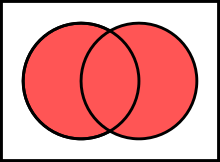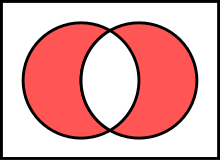Affirming a disjunct

The formal fallacy of affirming a disjunct also known as the fallacy of the alternative disjunct or a false exclusionary disjunct occurs when a deductive argument takes the following logical form:[1]
- A or B
- A
- Therefore, not B
Or in logical operators:
- ¬
Where denotes a logical assertion.
Explanation
[edit]

The fallacy lies in concluding that one disjunct must be false because the other disjunct is true; in fact they may both be true because "or" is defined inclusively rather than exclusively. It is a fallacy of equivocation between the operations OR and XOR.
Affirming the disjunct should not be confused with the valid argument known as the disjunctive syllogism.[2]
Examples
[edit]The following argument indicates the unsoundness of affirming a disjunct:
- Max is a mammal or Max is a cat.
- Max is a mammal.
- Therefore, Max is not a cat.
This inference is unsound because all cats, by definition, are mammals.
A second example provides a first proposition that appears realistic and shows how an obviously flawed conclusion still arises under this fallacy.[3]
- To be on the cover of Vogue Magazine, one must be a celebrity or very beautiful.
- This month's cover was a celebrity.
- Therefore, this celebrity is not very beautiful.
See also
[edit]References
[edit]- ^ Sinnott-Armstrong, Walter; Simmons, Claire (2021-12-15). "Some common fallacies in arguments from M/EEG data". NeuroImage. 245: 118725. doi:10.1016/j.neuroimage.2021.118725. ISSN 1095-9572. PMID 34813968.
- ^ Lay, Steven (2014). Introduction to Analysis with Proof, 5th edition. Pearson. ISBN 978-0321747471.
- ^ Rosen, Kenneth H. (2019). Discrete Mathematics and its Applications: Kenneth H. Rosen. McGraw-Hill. ISBN 978-1260091991.
External links
[edit]- Fallacy files: affirming a disjunct
- Bennett, Robert "Bo". "Affirming a Disjunct". Logically Fallacious. Retrieved 2023-07-29.




